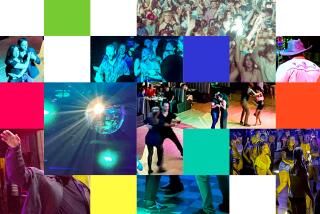Aerobics Music Has It All Worked Out : Exercise: It drives at a dependable beat that lays a solid foundation for choreography. The tempo is computed in heart rate.
- Share via
WASHINGTON — It’s not known for original hits, but when millions of Americans listen to aerobics music, they can’t stop dancing.
Aerobics music is its own art form--like ballet, but with more beat, more synthesizer and a simpler focus. Let the ballet composers worry about story lines; aerobics worries about warm-up, workout and cool-down.
The difference is clear in the way aerobics counts time. Like much other dance music, aerobics drives at a dependable beat that lays a solid foundation for choreography.
Unlike other dance music, however, its real tempo is computed in heart rate.
“How fast the music is is measured in beats per minute, following guidelines for people to conduct exercise classes,” said Mike Hossman, president of Dynamix, a Baltimore company that makes aerobic workout tapes.
Those guidelines fit on a bell-shaped curve, slower at both ends than it is in the middle, said Mike Babbitt, vice president of research and development at Power Productions in Gaithersburg, Md.
A typical, high-impact, 45-minute workout tape would start at 135 beats per minute, increase to about 160 and end at about 140, Babbitt said.
Less-strenuous workouts would go slightly more slowly, said Stephanie R. Carter, an aerobics instructor in Washington. For instance, a high-low aerobics workout might start at 125, work up to 150 and ease back to between 130 and 135, she said.
Aerobics music comes in several styles besides the standard dance music sound--among them, Latin, country and rap. They share a thumping bass beat that helps to keep the dancers in step.
The speed of the dance shapes the style of the music, the experts say.
For instance, the traditional disco feel of a lot of aerobics music grows from the fact that disco delivers a fast-beat, high-production style that fits well with fast aerobics, Hossman said.
“A lot of rhythms do not work well at that tempo,” he said. “You can’t do hip hop at 150 beats per minute. Hip hop typically works at 115 to 120.”
A lot of pop hits don’t make it into fast aerobics music either, said Babbitt: “A big hit by Madonna, you couldn’t utilize that at 130 beats per minute. It would sound pretty sped up and like Chipmunks or whatever.”
For that matter, name singers are out of the budget for aerobics music companies. These companies buy generic dance music from commercial record labels, or record their own.
The aerobics version might not be as slick, Hossman concedes: “Michael Jackson can spend a lot more than I can.”
Words on the tape tend to come in short thought patterns, Hossman said. However, differing styles have different lyrics, and tapes in a country style are more likely to tell a story, he said.
And, although the voices on the tape may utter words of love, they’re also likely to encourage you to keep moving.
“Once the exercise starts, what ends up happening is you don’t pay attention to the music,” Carter said. “You’re not exercising to go, ‘Oh, that’s my song.’ ”
Still, despite their limitations in art, the songs do work in exercise.
“Sometimes I am totally tired--until after that tape goes in,” Carter said. “Then, I’m ‘All right, here we go, everybody marching!’ ”


